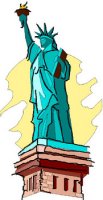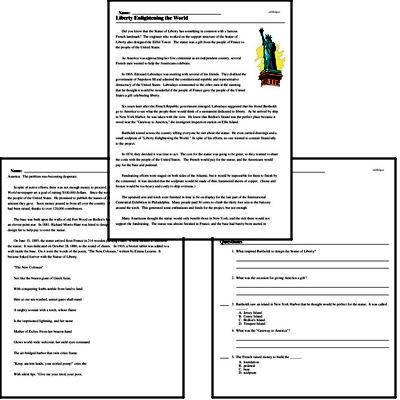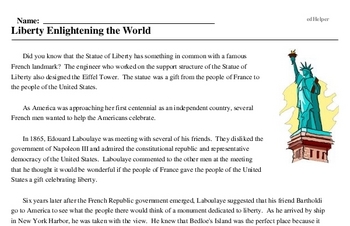Liberty Enlightening the World
Statue of Liberty Dedication Day
Reading Comprehension for October 28
Did you know that the Statue of Liberty has something in common with a famous French landmark? The engineer who worked on the support structure of the Statue of Liberty also designed the Eiffel Tower. The statue was a gift from the people of France to the people of the United States.
As America was approaching her first centennial as an independent country, several French men wanted to help the Americans celebrate.
In 1865, Edouard Laboulaye was meeting with several of his friends. They disliked the government of Napoleon III and admired the constitutional republic and representative democracy of the United States. Laboulaye commented to the other men at the meeting that he thought it would be wonderful if the people of France gave the people of the United States a gift celebrating liberty.
Six years later after the French Republic government emerged, Laboulaye suggested that his friend Bartholdi go to America to see what the people there would think of a monument dedicated to liberty. As he arrived by ship in New York Harbor, he was taken with the view. He knew that Bedloe's Island was the perfect place because it stood near the "Gateway to America," the immigrant inspection station on Ellis Island.
Bartholdi toured across the country telling everyone he met about the statue. He even carried drawings and a small sculpture of "Liberty Enlightening the World." In spite of his efforts, no one wanted to commit financially to the project.
In 1874, they decided it was time to act. The cost for the statue was going to be great, so they wanted to share the costs with the people of the United States. The French would pay for the statue, and the Americans would pay for the base and pedestal.
Fundraising efforts were staged on both sides of the Atlantic, but it would be impossible for them to finish by the centennial. It was decided that the sculpture would be made of thin, hammered sheets of copper. (Stone and bronze would be too heavy and costly to ship overseas.)
The upraised arm and torch were finished in time to be on display for the last part of the International Centennial Exhibition in Philadelphia. Many people paid 50 cents to climb the thirty foot arm to the balcony around the torch. This generated some enthusiasm and funds for the project, but not enough.
Many Americans thought the statue would only benefit those in New York, and the rich there would not support the fundraising. The statue was almost finished in France, and the base had barely been started in America. The problem was becoming desperate.
In spite of active efforts, there was not enough money to proceed. In 1884, Joseph Pulitzer got involved. His World newspaper set a goal of raising $100,000 dollars. Since the wealthy would not help, he took his cause to the people of the United States. He promised to publish the names of all contributors no matter how small the amount they gave. Soon money poured in from all over the country. Within a year, all the money they needed had been raised, thanks to over 120,000 contributors.
The base was built upon the walls of old Fort Wood on Bedloe's Island, which happened to be in the shape of an eleven-point star. In 1881, Richard Morris Hunt was hired to design and build the pedestal. He donated his design fee to help pay to erect the statue.
On June 15, 1885, the statue arrived from France in 214 wooden packing crates. It took months to assemble the statue. It was dedicated on October 28, 1886, to the sound of cheers. In 1903, a bronze tablet was added to a wall inside the base. On it were the words of the poem, "The New Colossus," written by Emma Lazarus. It became linked forever with the Statue of Liberty.




